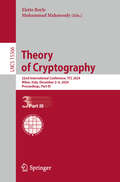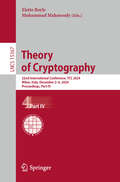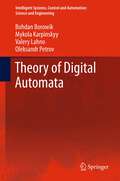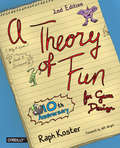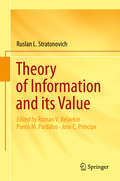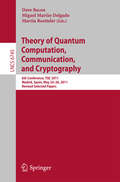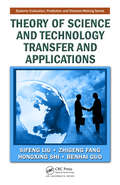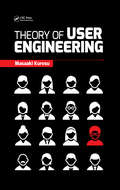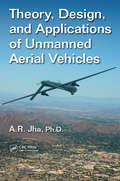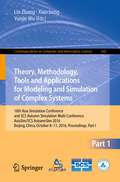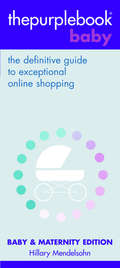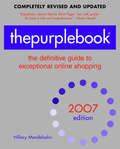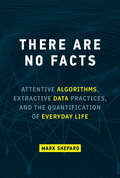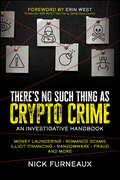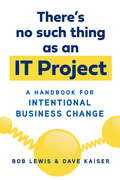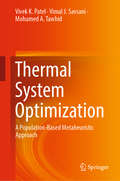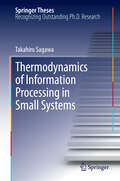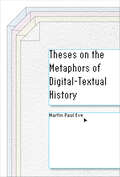- Table View
- List View
Theory of Cryptography: 22nd International Conference, TCC 2024, Milan, Italy, December 2–6, 2024, Proceedings, Part III (Lecture Notes in Computer Science #15366)
by Elette Boyle Mohammad MahmoodyThe four-volume set LNCS 15364-15367 constitutes the refereed proceedings of the 22nd International Conference on Theory of Cryptography, TCC 2024, held in Milan, Italy, in December 2024. The total of 68 full papers presented in the proceedings was carefully reviewed and selected from 172 submissions. They focus on topics such as: proofs; math and foundations; consensus and messaging; quantum; kolmogorov and OWFs; encryption; quantum and black-box separations; authentication and sequentiality; obfuscation and homomorphism; multi-party computation; information-theoretic cryptography; and secret sharing.
Theory of Cryptography: 22nd International Conference, TCC 2024, Milan, Italy, December 2–6, 2024, Proceedings, Part IV (Lecture Notes in Computer Science #15367)
by Elette Boyle Mohammad MahmoodyThe four-volume set LNCS 15364-15367 constitutes the refereed proceedings of the 22nd International Conference on Theory of Cryptography, TCC 2024, held in Milan, Italy, in December 2024. The total of 68 full papers presented in the proceedings was carefully reviewed and selected from 172 submissions. They focus on topics such as: proofs; math and foundations; consensus and messaging; quantum; kolmogorov and OWFs; encryption; quantum and black-box separations; authentication and sequentiality; obfuscation and homomorphism; multi-party computation; information-theoretic cryptography; and secret sharing.
Theory of Decision under Uncertainty
by Itzhak GilboaThis book describes the classical axiomatic theories of decision under uncertainty, as well as critiques thereof and alternative theories. It focuses on the meaning of probability, discussing some definitions and surveying their scope of applicability. The behavioral definition of subjective probability serves as a way to present the classical theories, culminating in Savage's theorem. The limitations of this result as a definition of probability lead to two directions - first, similar behavioral definitions of more general theories, such as non-additive probabilities and multiple priors, and second, cognitive derivations based on case-based techniques.
Theory of Digital Automata
by Oleksandr Petrov Mykola Karpinskyy Bohdan Borowik Valery LahnoThis book serves a dual purpose: firstly to combine the treatment of circuits and digital electronics, and secondly, to establish a strong connection with the contemporary world of digital systems. The need for this approach arises from the observation that introducing digital electronics through a course in traditional circuit analysis is fast becoming obsolete. Our world has gone digital. Automata theory helps with the design of digital circuits such as parts of computers, telephone systems and control systems. A complete perspective is emphasized, because even the most elegant computer architecture will not function without adequate supporting circuits. The focus is on explaining the real-world implementation of complete digital systems. In doing so, the reader is prepared to immediately begin design and implementation work. This work serves as a bridge to take readers from the theoretical world to the everyday design world where solutions must be complete to be successful.
Theory of Fun for Game Design
by Raph KosterNow in full color, the 10th anniversary edition of this classic book takes you deep into the influences that underlie modern video games, and examines the elements they share with traditional games such as checkers. At the heart of his exploration, veteran game designer Raph Koster takes a close look at the concept of fun and why it’s the most vital element in any game.Why do some games become boring quickly, while others remain fun for years? How do games serve as fundamental and powerful learning tools? Whether you’re a game developer, dedicated gamer, or curious observer, this illustrated, fully updated edition helps you understand what drives this major cultural force, and inspires you to take it further.You’ll discover that:Games play into our innate ability to seek patterns and solve puzzlesMost successful games are built upon the same elementsSlightly more females than males now play gamesMany games still teach primitive survival skillsFictional dressing for modern games is more developed than the conceptual elementsTruly creative designers seldom use other games for inspirationGames are beginning to evolve beyond their prehistoric origins
Theory of Information and its Value
by Ruslan L. StratonovichThis English version of Ruslan L. Stratonovich’s Theory of Information (1975) builds on theory and provides methods, techniques, and concepts toward utilizing critical applications. Unifying theories of information, optimization, and statistical physics, the value of information theory has gained recognition in data science, machine learning, and artificial intelligence. With the emergence of a data-driven economy, progress in machine learning, artificial intelligence algorithms, and increased computational resources, the need for comprehending information is essential. This book is even more relevant today than when it was first published in 1975. It extends the classic work of R.L. Stratonovich, one of the original developers of the symmetrized version of stochastic calculus and filtering theory, to name just two topics.Each chapter begins with basic, fundamental ideas, supported by clear examples; the material then advances to great detail and depth. The reader is not required to be familiar with the more difficult and specific material. Rather, the treasure trove of examples of stochastic processes and problems makes this book accessible to a wide readership of researchers, postgraduates, and undergraduate students in mathematics, engineering, physics and computer science who are specializing in information theory, data analysis, or machine learning.
Theory of JIZAI Body: Towards Mastery Over the Extended Self
by Masahiko InamiThis book proposes a novel body image to bridge gap between self-transformation and preserving sense of self: the Jizai body. Automation and digitization have served to transform our lives. Digital transformation, for example, is rapidly changing the world every day, making life more convenient and comfortable. However, there is a worrying trend of removing the human element from human-centric systems as technologies and algorithms become more capable. Leaving humanity behind, especially its corporal components, will leave persons unable to feel a sense of self in their newfound comfort. Despite the allure of an automated life, it is doubtful that the authors will find happiness without a sense of control. Exploring the essence of what makes us human from a physiological and psychological standpoint, the authors present a new perspective on what constitutes a body in this era where the real physical world and virtual information world coexist. The authors present state-of-the-art research which seeks to free humanity from its physical constraints and allow free control of both the natural and extended body. The next step in human evolution starts here.
Theory of Practical Cellular Automaton
by Xuewei Li Jinpei Wu Xueyan LiThis book addresses the intellectual foundations, function, modeling approaches and complexity of cellular automata; explores cellular automata in combination with genetic algorithms, neural networks and agents; and discusses the applications of cellular automata in economics, traffic and the spread of disease. Pursuing a blended approach between knowledge and philosophy, it assigns equal value to methods and applications.
Theory of Quantum Computation, Communication, and Cryptography
by Dave Bacon Miguel Martin-Delgado Martin RoettelerThis book constitutes the thoroughly refereed post-conference proceedings of the 6th Conference on Theory of Quantum Computation, Communication, and Cryptography, TQC 2011, held in Madrid, Spain, in May 2011. The 14 revised papers presented were carefully selected from numerous submissions. The papers present new and original research and cover a large range of topics in quantum computation, communication and cryptography, a new and interdisciplinary field at the intersection of computer science, information theory and quantum mechanics.
Theory of Science and Technology Transfer and Applications
by Sifeng Liu Zhigeng Fang Hongxing Shi Benhai GuoConstructive Suggestions for Efficiently Implementing Technology Transfer Theory of Science and Technology Transfer and Applications presents the mechanisms, features, effects, and modes of technology transfer. It addresses the measurement, cost, benefit, optimal allocation, and game theory of technology transfer, along with the dynamics of the tec
Theory of User Engineering
by Masaaki KurosuThis book outlines the new concept of user engineering and covers the diversity of users, along with the business process that includes the design and the user’s experience processes. Although the concept of user experience (UX) has become popular, the definition and the methodology are still ambiguous. User engineering is similar to the user-centered design, but differs in that its scope is not limited to the design process but concerns the whole manufacturing process and the whole usage process, i.e., the whole lifecycle of an artifact. User’s perspective is strongly emphasized in this book, hence, its stance is far from that of the marketing approach that usually fails to notice the life and experiences of users after the purchase of an artifact as consumers. Theory of User Engineering differentiates between the quality in design and the quality in use, and the objective quality characteristics and the subjective quality characteristics. In addition to the user research using ethnographic methods, the author introduces a new approach based on the artifact evolution theory that can be adopted in the planning stage.
Theory, Analysis and Design of RF Interferometric Sensors
by Seoktae Kim Cam NguyenTheory, Analysis and Design of RF Interferometric Sensors presents the theory, analysis and design of RF interferometric sensors. RF interferometric sensors are attractive for various sensing applications that require every fine resolution and accuracy as well as fast speed. The book also presents two millimeter-wave interferometric sensors realized using RF integrated circuits. The developed millimeter-wave homodyne sensor shows sub-millimeter resolution in the order of 0.05 mm without correction for the non-linear phase response of the sensor's quadrature mixer. The designed millimeter-wave double-channel homodyne sensor provides a resolution of only 0.01 mm, or 1/840th of the operating wavelength, and can inherently suppress the non-linearity of the sensor's quadrature mixer. The experimental results of displacement and velocity measurement are presented as a way to demonstrate the sensing ability of the RF interferometry and to illustrate its many possible applications in sensing. The book is succinct, yet the material is very much self-contained, enabling readers with an undergraduate background in electrical engineering or physics with some experiences or graduate courses in RF circuits to understand easily.
Theory, Design, and Applications of Unmanned Aerial Vehicles
by A. R. Jha, Ph.D.This book provides a complete overview of the theory, design, and applications of unmanned aerial vehicles. It covers the basics, including definitions, attributes, manned vs. unmanned, design considerations, life cycle costs, architecture, components, air vehicle, payload, communications, data link, and ground control stations. Chapters cover types and civilian roles, sensors and characteristics, alternative power, communications and data links, conceptual design, human machine interface, sense and avoid systems, civil airspace issues and integration efforts, navigation, autonomous control, swarming, and future capabilities.
Theory, Methodology, Tools and Applications for Modeling and Simulation of Complex Systems: 16th Asia Simulation Conference and SCS Autumn Simulation Multi-Conference, AsiaSim/SCS AutumnSim 2016, Beijing, China, October 8-11, 2016, Proceedings, Part I (Communications in Computer and Information Science #643)
by Lin Zhang Xiao Song Yunjie WuThis four-volume set (CCIS 643, 644, 645, 646) constitutes the refereed proceedings of the 16th Asia Simulation Conference and the First Autumn Simulation Multi-Conference, AsiaSim / SCS AutumnSim 2016, held in Beijing, China, in October 2016. The 265 revised full papers presented were carefully reviewed and selected from 651 submissions. The papers in this first volume of the set are organized in topical sections on modeling and simulation theory and methodology; model engineering for system of systems; high performance computing and simulation; modeling and simulation for smart city.
Thepurplebook Baby: The Definitive Guide to Exceptional Online Shopping
by Hillary Mendelsohn Lawrence Butler Ian AndersonFrom essential gear like baby strollers and car seats to the fun accessories, thebabypurplebook is the all-new companion guide to thepurplebook and the ultimate resource for finding the best baby and maternity products online.
Thepurplebook, 2007 Edition: The Definitive Guide to Exceptional Online Shopping
by Hillary Mendelsohn Lawrence Butler Ian AndersonGet out of the mall and on to your computer. With the click of your mouse and the completely updated 2007 edition of thepurplebook[Registered], you've got a 24-7 invitation to window-shop at over 1,600 of the Internet's best sites (including hundreds of newly discovered Web retailers). This user-friendly, thoroughly researched guide unlocks the true potential of online shopping by showing you first-rate places to find the products you seek and uncovering incredible sites you never dreamed existed, whether you want to express your personal style, find the perfect gift, or simply make life a little more convenient. From functional to fabulous, trendsetter to traditional, bargain basement to designer luxe, you'll find something to fit every taste, style, and budget. Shop till you drop with: Outstanding quality--more than 40,000 sites were screened for the book, and each one that made the cut promises a do-not-miss experience for the savvy shopper! Helpful consumer tips-advice for avoiding fraudulent charges, identity theft, spam, and other rip-offs, Customer service telephone numbers-the notoriously hard-to-find number that puts you in direct contact with a service representative. Thepurplebook makes it easy to find the right something for yourself and everyone on your shopping list, in each of these essential categories: Art & Collectibles, Crafts & Hobbies, Entertainment, Epicurean, Gadgets & Electronics, Health & Beauty, Home & Garden, Lifestyles & Megastores, Maternity, Men's Apparel, Minors, Pets, Seniors, Shoes & Accessories, Sports & Gifts, Travel, Women's Apparel, Charity.
There Are No Facts: Attentive Algorithms, Extractive Data Practices, and the Quantification of Everyday Life
by Mark ShepardThe entanglements of people and data, code and space, knowledge and power: how data and algorithms shape the world—and shape us within that world.With the emergence of a post-truth world, we have witnessed the dissolution of the common ground on which truth claims were negotiated, individual agency enacted, and public spheres shaped. What happens when, as Nietzsche claimed, there are no facts, but only interpretations? In this book, Mark Shepard examines the entanglements of people and data, code and space, knowledge and power that have produced an uncommon ground—a disaggregated public sphere where the extraction of behavioral data and their subsequent processing and sale have led to the emergence of micropublics of ever-finer granularity. Shepard explores how these new post-truth territories are propagated through machine learning systems and social networks, which shape the public and private spaces of everyday life. He traces the balkanization and proliferation of online news and the targeted distribution of carefully crafted information through social media. He examines post-truth practices, showing how truth claims are embedded in techniques by which the world is observed, recorded, documented, and measured. Finally, he shows how these practices play out, at scales from the translocality of the home to the planetary reach of the COVID-19 pandemic—with stops along the way at an urban minimarket, an upscale neighborhood for the one percent, a Toronto waterfront district, and a national election.
There's No Such Thing as Crypto Crime: An Investigative Handbook
by Nick FurneauxHands-on guidance for professionals investigating crimes that include cryptocurrency In There’s No Such Thing as Crypto Crime: An Investigators Guide, accomplished cybersecurity and forensics consultant Nick Furneaux delivers an expert discussion of the key methods used by cryptocurrency investigators, including investigations on Bitcoin and Ethereum type blockchains. The book explores the criminal opportunities available to malicious actors in the crypto universe, as well as the investigative principles common to this realm. The author explains in detail a variety of essential topics, including how cryptocurrency is used in crime, exploiting wallets, and investigative methodologies for the primary chains, as well as digging into important areas such as tracing through contracts, coin-swaps, layer 2 chains and bridges. He also provides engaging and informative presentations of: Strategies used by investigators around the world to seize the fruits of crypto-related crime How non-fungible tokens, new alt-currency tokens, and decentralized finance factor into cryptocurrency crime The application of common investigative principles—like discovery—to the world of cryptocurrency An essential and effective playbook for combating crypto-related financial crime, There’s No Such Thing as Crypto Crime will earn a place in the libraries of financial investigators, fraud and forensics professionals, and cybercrime specialists.
There's No Such Thing as an IT Project: A Handbook for Intentional Business Change
by Bob Lewis Dave KaiserLearn how to stop pouring vast sums of money into technology projects that don't have a lasting impact by closing the communication gap between IT and leadership.Too many businesses miss opportunity after opportunity to design, plan, and achieve intentional business change. Why? Because they charter projects focused on delivering software products: IT projects. But as this groundbreaking book points out, there's no such thing as an IT project—or at least there shouldn't be. It's always about intentional business change, or what's the point?It's time to stop providing simplistic, one-dimensional, all-you-gotta-do panaceas. When the only constant in business is change, truly useful IT has to help you change instead of build solutions that are obsolete even before they are completed. IT consultant Bob Lewis, author of the bestselling Bare Bones Project Management, has joined forces with seasoned CIO Dave Kaiser to give you the tools you need. It's a multidimensional, relentlessly practical guide. Condensed to handbook length and seasoned with Lewis's trademark sardonic humor, it's an enjoyable and digestible read as well.Lewis and Kaiser take you step by step through the process of building a collaboration between IT and the rest of the business that really works. Insisting on intentional business change takes patience, communication, and courage, but it has a huge payoff. More to the point, insist on anything else and every penny you spend will be a wasted dime and a waste of time.
Thermal Cameras in Science Education (Innovations in Science Education and Technology #26)
by Jesper Haglund Fredrik Jeppsson Konrad J. SchönbornThis book presents a collection of educational research and developmental efforts on the rapidly emerging use of infrared cameras and thermal imaging in science education. It provides an overview of infrared cameras in science education to date, and of the physics and technology of infrared imaging and thermography. It discusses different areas of application of infrared cameras in physics, chemistry and biology education, as well as empirical research on students’ interaction with the technology. It ends with conclusions drawn from the contributions as a whole and a formulation of forward-looking comments.
Thermal Physics Tutorials with Python Simulations (Series in Computational Physics)
by Minjoon Kouh Taejoon KouhThis book provides an accessible introduction to thermal physics with computational approaches that complement the traditional mathematical treatments of classical thermodynamics and statistical mechanics. It guides readers through visualizations and simulations in the Python programming language, helping them to develop their own technical computing skills (including numerical and symbolic calculations, optimizations, recursive operations, and visualizations). Python is a highly readable and practical programming language, making this book appropriate for students without extensive programming experience. This book may serve as a thermal physics textbook for a semester-long undergraduate thermal physics course or may be used as a tutorial on scientific computing with focused examples from thermal physics. This book will also appeal to engineering students studying intermediate-level thermodynamics as well as computer science students looking to understand how to apply their computer programming skills to science. Key features Major concepts in thermal physics are introduced cohesively through computational and mathematical treatments. Computational examples in Python programming language guide students on how to simulate and visualize thermodynamic principles and processes for themselves.
Thermal Stability of Metastable Magnetic Skyrmions (Springer Theses)
by Louise DesplatThe energy cost associated with modern information technologies has been increasing exponentially over time, stimulating the search for alternative information storage and processing devices. Magnetic skyrmions are solitonic nanometer-scale quasiparticles whose unique topological properties can be thought of as that of a Mobius strip. Skyrmions are envisioned as information carriers in novel information processing and storage devices with low power consumption and high information density. As such, they could contribute to solving the energy challenge.In order to be used in applications, isolated skyrmions must be thermally stable at the scale of years. In this work, their stability is studied through two main approaches: the Kramers' method in the form of Langer's theory, and the forward flux sampling method. Good agreement is found between the two methods. We find that small skyrmions possess low internal energy barriers, but are stabilized by a large activation entropy. This is a direct consequence of the existence of stable modes of deformation of the skyrmion. Additionally, frustrated exchange that arises at some transition metal interfaces leads to new collapse paths in the form of the partial nucleation of the corresponding antiparticle, as merons and antimerons.
Thermal System Optimization: A Population-Based Metaheuristic Approach
by Vimal J. Savsani Vivek K. Patel Mohamed A. TawhidThis book presents a wide-ranging review of the latest research and development directions in thermal systems optimization using population-based metaheuristic methods. It helps readers to identify the best methods for their own systems, providing details of mathematical models and algorithms suitable for implementation. To reduce mathematical complexity, the authors focus on optimization of individual components rather than taking on systems as a whole. They employ numerous case studies: heat exchangers; cooling towers; power generators; refrigeration systems; and others. The importance of these subsystems to real-world situations from internal combustion to air-conditioning is made clear. The thermal systems under discussion are analysed using various metaheuristic techniques, with comparative results for different systems. The inclusion of detailed MATLAB® codes in the text will assist readers—researchers, practitioners or students—to assess these techniques for different real-world systems. Thermal System Optimization is a useful tool for thermal design researchers and engineers in academia and industry, wishing to perform thermal system identification with properly optimized parameters. It will be of interest for researchers, practitioners and graduate students with backgrounds in mechanical, chemical and power engineering.
Thermodynamics of Information Processing in Small Systems
by Takahiro SagawaThis thesis presents a general theory of nonequilibrium thermodynamics for information processing. Ever since Maxwell's demon was proposed in the nineteenth century, the relationship between thermodynamics and information has attracted much attention because it concerns the foundation of the second law of thermodynamics. From the modern point of view, Maxwell's demon is formulated as an information processing device that performs measurement and feedback at the level of thermal fluctuations. By unifying information theory, measurement theory, and the recently developed theory of nonequilibrium statistical mechanics, the author has constructed a theory of "information thermodynamics," in which information contents and thermodynamic variables are treated on an equal footing. In particular, the maximum work that can be extracted by the demon and the minimum work that is needed for measurement and information erasure by the demon has been determined. Additionally, generalizations of nonequilibrium relations such as a Jarzynski equality for classical stochastic systems in the presence of feedback control have been derived. One of the generalized equalities has recently been verified experimentally by using sub-micron colloidal particles. The results obtained serve as fundamental principles for information processing in small thermodynamic systems, and are applicable to nanomachines and nanodevices.
Theses on the Metaphors of Digital-Textual History (Stanford Text Technologies)
by Martin Paul EveDigital spaces are saturated with metaphor: we have pages, sites, mice, and windows. Yet, in the world of digital textuality, these metaphors no longer function as we might expect. Martin Paul Eve calls attention to the digital-textual metaphors that condition our experience of digital space, and traces their history as they interact with physical cultures. Eve posits that digital-textual metaphors move through three life phases. Initially they are descriptive. Then they encounter a moment of fracture or rupture. Finally, they go on to have a prescriptive life of their own that conditions future possibilities for our text environments—even when the metaphors have become untethered from their original intent. Why is "whitespace" white? Was the digital page always a foregone conclusion? Over a series of theses, Eve addresses these and other questions in order to understand the moments when digital-textual metaphors break and to show us how it is that our textual softwares become locked into paradigms that no longer make sense. Contributing to book history, literary studies, new media studies, and material textual studies, Theses on the Metaphors of Digital-Textual History provides generative insights into the metaphors that define our digital worlds.
